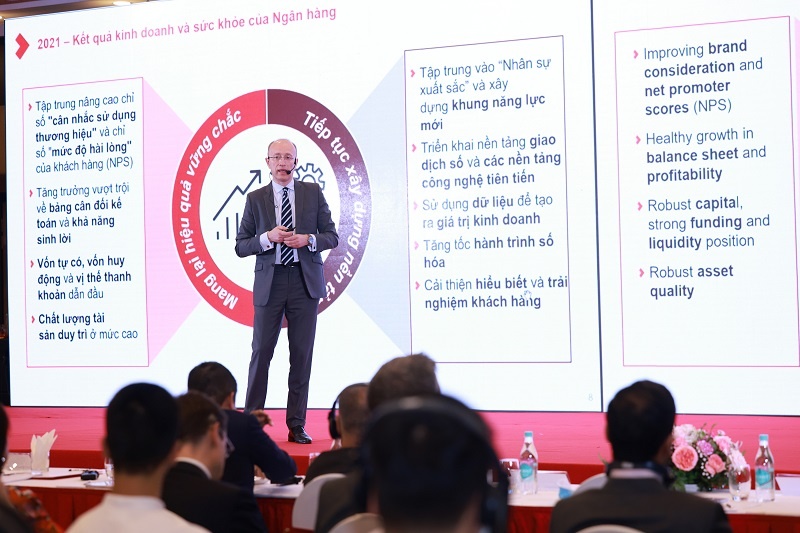Digital, data, and human excellence are key in Techcombank’s transformation journey
 |
| Jens Lottner, CEO of Techcombank |
Last year, the bank posted over $1.6 billion in total operating income, up 35.4 per cent on-year. The bank’s profit before tax (PBT) rose to $1 billion, making Techcombank the first non-state-owned lender to join Vietnam’s billion-dollar profit club. This achievement was the culmination of five consecutive years of double-digit PBT growth, at a compound average growth rate (CAGR) of an impressive 50 per cent between 2016 and 2021.
The bank’s performance remained resilient even as the pandemic cast its shadow over local markets and several waves of infections caused disruption to businesses and people’s lives. Despite these challenges, Techcombank grew its total assets by 29.4 per cent, to almost $25 billion, and delivered an industry-leading return on assets of 3.7 per cent according to the bank.
It was also able to maintain an impressive current account and savings account ratio, which reached 50.5 per cent at the end of 2021. Its capital adequacy ratio was 15 per cent, while the non-performing loans ratio stood at 0.7 per cent, and the loan loss coverage ratio was 162.9 per cent.
Underpinning Techcombank’s performance and enabling the resilience of its business model were ongoing investments in technology, scaling up its data, and developing human capital, Lottner explained.
In a candid interview, Lotter talked in detail about the trends and dynamics impacting the banking industry in Vietnam and how Techcombank is transforming itself to be ready for a digital future.
 |
The bank has witnessed strong profit growth in 2021. Does the 16 per cent growth target for 2022 seem too cautious?
From 2015 to 2021, our PBT grew at a CAGR of around 50 per cent. As we scale, the bank will reach a size where it won’t be possible to grow at that rate every year. We set a target of 16 per cent which we feel is highly achievable and note that this still means $174 million more than last year. Is more than that possible? Yes certainly, we could achieve 40 per cent growth this year if Vietnam’s economy continues to recover and the tailwinds are favourable, but not everything is in our control.
How about your $20 billion market cap target by 2025? Isn’t the market correcting?
If you see our current trajectory, the way our earnings are increasing, and the potential for growth as the Vietnamese economy recovers, I think at the end of 2025, we could easily be at around $8 billion equity value. Our pre-tax earnings could be above $2 billion if we continue on our current growth trajectory.
If you have these numbers, the question is then on what multiple are we trading? If you look at banks across the region that are showing the types of numbers we have in terms of the growth and return on assets, they usually trade at 3-4 times book. These multiples are ahead of our plan and we have achieved what we wanted for 2022 already in 2021.
To get there, you seem to be betting big on technology. Please take us through your technology investment.
One of the priority areas in which we are investing is our transaction banking capability through our digital mobile app. We want to bring differentiation to the app through the application of data analysis, so for example, if you are a new-to-bank customer we can still underwrite you by quickly developing a credit score that uses up to six external data sources.
The ability to interact with customers, understand them, and provide tailored financial solutions to meet their needs through our app, just as we would do in a branch, is the customer experience we want to create. Our plan is to have 5 million customers migrated completely onto the digital platform by the end of this year. We currently have around 400 people working on enhancing these digital capabilities.
We have set aside $500 million for tech investments over the next five years. Up to now, we have deployed between 15 and 20 per cent of that total amount, but we expect to see an acceleration of our investment in the years ahead as we implement larger-scale tech initiatives. We are committed to deploying this capital responsibly and in ways that will help to transform the bank, make us more efficient, and give our customers the best digital experience possible.
 |
Within the tech categories, Techcombank seems to be very aggressive in data. We’ve heard you’re building a data lake, can you tell us more?
Our data lake initiative involves collecting and aggregating data from different areas in the bank, and because it's so big, we have decided to put this data lake on the cloud. We have identified the data set we want to store in the cloud, and around 70-80 per cent of the data has now been transferred.
We are also building an analytics infrastructure to enable us to analyse the data to better understand our customers, provide a more holistic view of their needs, and enable the bank to make better and faster decisions over the types of products and services to offer.
The next step will be to connect our app to the data lake infrastructure so that we make better decisions across all of our customer engagement channels.
What makes Techcombank's mobile app different from those of other banks?
We want our mobile app platform to not just be a service platform, but to have the feeling of human touch that understands what a customer needs. That human interaction, when it comes at the scale of 15 million or 20 million customers, will only work if you connect a lot of different elements, from infrastructure to data and front end systems and machine learning.
We also want to provide customers with an experience that is seamless across our different channels, from the branches to our digital platform. There is probably only a handful of banks in the world that are anywhere close to offering this type of seamless experience for their customers and I think it will be a focus for many banks over the next 10-15 years.
Look at Google, every single time more people use it, it learns more and becomes even better. It's a virtuous cycle that is very hard to replicate.
What do you make of the level of digitalisation by Vietnamese banks, compared to others in the region? What changes need to be made in terms of regulations when it comes to data protection in the cloud?
I think we are 5 to 10 years behind compared to where banks in other markets are, but we are catching up fast. The main differences are in the technology stack. How scalable are the systems? How easy is it to make changes and create new capabilities? How long does it take to get to market? A lot of the systems used by Vietnamese banks are very tightly integrated compared to what we see in other markets and this makes it harder to create new customer experiences.
In terms of the legal frameworks, I think that the local regulator, in certain areas, is much more open than in others. For example, moving to the cloud would have been much more difficult in Singapore, Thailand, or Malaysia.
People might say that we are too lax with data privacy, but that's not true. If you look at how much money AWS, Google, and Microsoft are investing to strengthen their data protection, it's much safer to be up in the cloud than somewhere in a local data centre. From that perspective, I think the regulator has the right perspective in terms of what they are intending to do.
However, probably some of the legal frameworks need to be enforced. If there is a stronger sandbox regime, where people can test things in a lot of areas, it would be much more helpful. Through this sandbox regime, and through working with the banks, we could come up with solutions. If the banks can make the right case, regulators are willing to entertain us. It can only be on a pilot level at the beginning, but regulators understand that they need to do something.
Throughout your transformation process, you’re beefing up the team with a lot of overseas hires. How will it change the bank's performance?
There are certain skills and capabilities we need, that we believe are not in the country. But everyone who's coming here has a very clear mandate to pass down his or her experiences to the staff. Ultimately, we will not be able to rely on constantly importing talent.
Within Techcombank, we're not making a big differentiation between local and foreign experts and Vietnamese returning from overseas. A lot of the people we're having now are really building a career with the bank. On the other hand, as we start transforming, our aspiration is to become one of the leading banks in ASEAN. So for a lot of experts, this becomes a very different proposition for them. They are excited by the growth, the quality of work, and the people they're working with.
What the stars mean:
★ Poor ★ ★ Promising ★★★ Good ★★★★ Very good ★★★★★ Exceptional
Related Contents
Latest News
More News
- Experts flag gaps as national financial strategy under review (December 12, 2025 | 15:13)
- Global gold exchange models offer roadmap for Vietnamese market (December 12, 2025 | 11:58)
- Five million household businesses to adopt self-declared tax system (December 11, 2025 | 18:13)
- Vietnam establishes management board for crypto asset trading market (December 11, 2025 | 18:11)
- ACB offers financing to fit Vietnam’s textile and garment industry (December 11, 2025 | 09:07)
- Vietnam accelerates push for open banking (December 10, 2025 | 11:58)
- Reshaping the country’s digital finance sector (December 09, 2025 | 21:12)
- VIB's Dual Earnings solution reshapes personal money management (December 09, 2025 | 10:06)
- Foreign funds accumulate consumer stocks in Vietnam (December 08, 2025 | 11:36)
- Listed companies honoured for information transparency (December 06, 2025 | 11:59)

 Tag:
Tag:






















 Mobile Version
Mobile Version